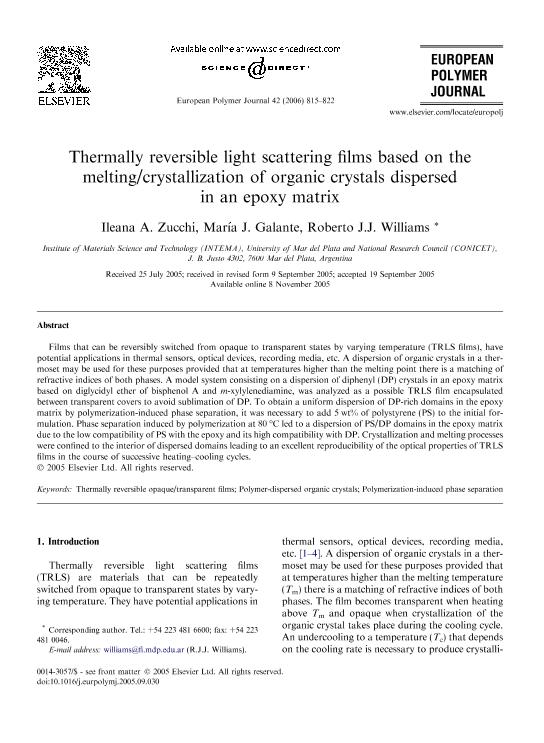Artículo
Thermally reversible light scattering films based on the melting/crystallization of organic crystals dispersed in an epoxy matrix
Fecha de publicación:
08/04/2006
Editorial:
Pergamon-Elsevier Science Ltd
Revista:
European Polymer Journal
ISSN:
0014-3057
Idioma:
Inglés
Tipo de recurso:
Artículo publicado
Clasificación temática:
Resumen
Films that can be reversibly switched from opaque to transparent states by varying temperature (TRLS films), have potential applications in thermal sensors, optical devices, recording media, etc. A dispersion of organic crystals in a thermoset may be used for these purposes provided that at temperatures higher than the melting point there is a matching of refractive indices of both phases. A model system consisting on a dispersion of diphenyl (DP) crystals in an epoxy matrix based on diglycidyl ether of bisphenol A and m-xylylenediamine, was analyzed as a possible TRLS film encapsulated between transparent covers to avoid sublimation of DP. To obtain a uniform dispersion of DP-rich domains in the epoxy matrix by polymerization-induced phase separation, it was necessary to add 5 wt% of polystyrene (PS) to the initial formulation. Phase separation induced by polymerization at 80 °C led to a dispersion of PS/DP domains in the epoxy matrix due to the low compatibility of PS with the epoxy and its high compatibility with DP. Crystallization and melting processes were confined to the interior of dispersed domains leading to an excellent reproducibility of the optical properties of TRLS films in the course of successive heating–cooling cycles.
Archivos asociados
Licencia
Identificadores
Colecciones
Articulos(INTEMA)
Articulos de INST.DE INV.EN CIENCIA Y TECNOL.MATERIALES (I)
Articulos de INST.DE INV.EN CIENCIA Y TECNOL.MATERIALES (I)
Citación
Zucchi, Ileana Alicia; Galante, Maria Jose; Williams, Roberto Juan Jose; Thermally reversible light scattering films based on the melting/crystallization of organic crystals dispersed in an epoxy matrix; Pergamon-Elsevier Science Ltd; European Polymer Journal; 42; 4; 8-4-2006; 815-822
Compartir
Altmétricas




